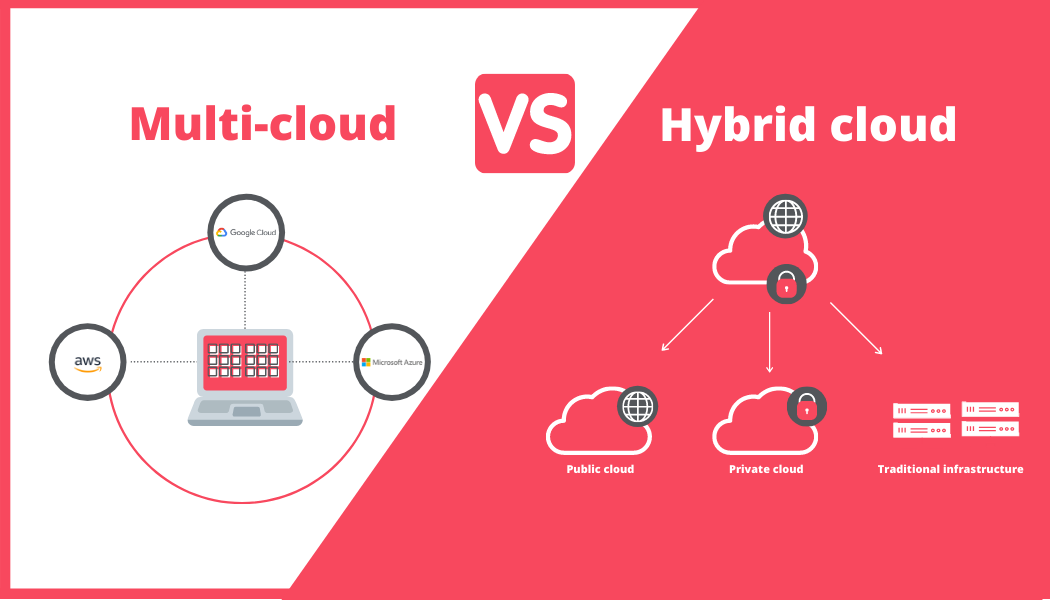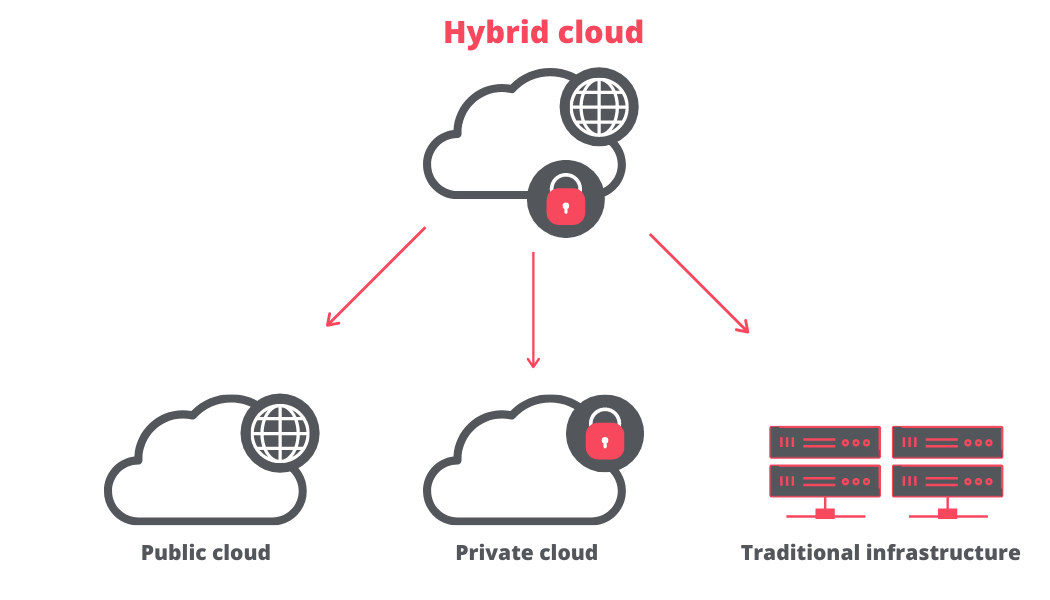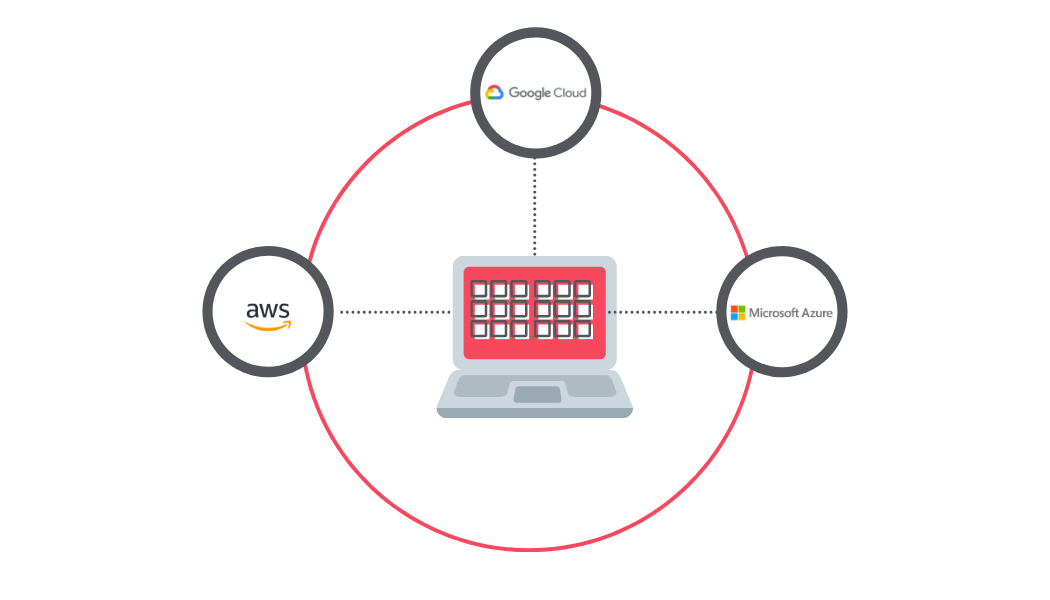Today’s cloud ecosystem has a variety of different cloud strategies designed to suit organisations’ needs around infrastructure, workloads, security, and more. Hybrid cloud and multi-cloud are two terms that are often confused. What makes a multi-cloud deployment different from hybrid cloud? What’s the difference between both? Are these just other IT buzzwords? Let’s break it down and discover the differences between hybrid cloud & multi-cloud.

Multi-cloud and hybrid cloud-computing are similar, but have different IT infrastructure models.
First, we want to talk more about what Hybrid & Multi-cloud are which are the advantages that these cloud strategies have. After that, we will dive deeper into the differences and compare hybrid with multi-Cloud.
What is Hybrid Cloud?

For most businesses, finding the best cloud solution is a mix of public and private cloud. Hybrid cloud means that your organisation combines one or more public clouds with a private cloud, or with on-premises infrastructure. It’s a marriage between your private cloud infrastructure or on-prem and a single public cloud.
This means that your organisation is using a mix of computing, storage, and services environments (on-premises infrastructure, private cloud services, and a public cloud). With hybrid Cloud, there is a clear orchestration among the various platforms.
The difference between a private cloud service and a public cloud
Public clouds traditionally ran off-premises. With a public cloud each customer’s data and applications running in the cloud remain hidden from other cloud customers. Businesses can pick from a wide range of public cloud services.
All hardware-based networking, storage, and compute resources are owned and managed by the third-party public cloud provider like Amazon Web Services (AWS), Microsoft Azure, or Google Cloud Platform (GCP) – the last one being our absolute favourite as a Google Cloud Premier partner!.
Private clouds traditionally ran on-premises. This type of cloud service isn’t shared with any other organisation. The private cloud user has the cloud to themselves. Private cloud has some limitations. Let’s take a look at some of them:
- Cost: With a private Cloud you have to build out the entire data center infrastructure yourself. If you plan to build your own private cloud, you face a large capital outlay.
- Under-utilisation: the cost of capacity under-utilisation is a cost to you, not to your provider. Managing and maximising utilisation becomes the concern of your organisation.
- Platform scaling: large upward changes in your requirements are likely to require scaling of the physical infrastructure. It might take longer than simply scaling a virtual machine within existing capacity.
But what is the difference between traditional infrastructure & private cloud?
Traditional infrastructure is a customised, dedicated system that’s ideal for organisations that need to run many different types of applications. Businesses with this infrastructure must purchase additional hardware and upgrades in order to scale up their data storage and services to support more users.
What about the difference then with private cloud?
Instead of being accessible via physical hardware, all servers, software and networks are hosted in the cloud, off premises. Private cloud can also offer managed services. So rather than investing your money in new physical servers in-house, you rent the data storage space from a cloud computing provider. This is more cost effective.
Here are some characteristics that are typical for a successful hybrid cloud environment:
- A centralised identity infrastructure across multiple environments
- A secure high-speed connectivity between the enterprise and the cloud environment
- An integrated network that creates a segmented but single overall network infrastructure
- A monitoring and resource management
- Your on-premises data center, private and public cloud resources, and workloads are tied together under one governance management.
Is Hybrid Cloud right for your organisation?
Many organisations are opting for a hybrid mixture of cloud services. A Hybrid Cloud creates a flexible platform that can meet a broad range of your organisation’s needs, including flexibility and security needs.
Let’s take a look at some specific benefits of hybrid cloud:
- Access to data to better support remote workforce: all your employees have access to data anytime from anywhere. With a hybrid cloud strategy you give your organisation the flexibility to support the remote employees with on-demand access to data that isn’t tied to one central location.
- Reduced costs : when demand spikes, your organisation can avoid huge capital expenditures (and thus breaking the bank) to expand their infrastructure and instead pay only for the cloud resources they use.
- Improved scalability and control: thanks to an increased automation you can adjust your cloud settings to respond automatically to changes in demand, optimise performance and efficiency.
- Security and risk management: a hybrid cloud strategy gives organisations control over their data and improves the security by reducing the potential exposure of data. The organisation can choose where to house their data and workloads. It also makes it easier to implement strong technical security measures such as encryption, automation, access control, orchestration, and endpoint security.
Ultimately, you must weigh the pros and cons of a hybrid solution against the needs and priorities of your organisation.
Google Cloud Hybrid Cloud
Need to run your workloads on-prem? Anthos is a real game changer. It’s a hybrid platform that’s managed by Google Cloud.
Anthos perfectly integrates with your existing on-prem stack. It provides you a well-supported path for you to modernise your infrastructure.
With Anthos, organisations can modernise anywhere, including those on-premises or in the cloud. Anthos provides a unified management experience across on-premises and cloud environments.
What is Multi-cloud ?
Multi-Cloud is a deployment model that leverages multiple types of cloud services. A business may use one public cloud as a database for example and another public cloud for scaling out the compute for example. Some providers are better for certain tasks than others. This way you get the best benefits from each unique service.
Multi-cloud deployments are usually part of a strategy to avoid vendor lock-ins with a single cloud service provider.
Why would you choose for Multi-cloud?
Well, there can be several reasons for that:
- You already use a public cloud provider but another provider offers a service that your current provider doesn’t offer.
- You don’t want to migrate all your services, so you opt for a multi-cloud strategy.
- You don’t want to keep all your eggs in one basket. A diverse infrastructure can be more efficient and cost-effective.
Is a Multi-Cloud strategy right for your organisation?
With a multi-cloud strategy your organisation will be able to invest in digital transformation without getting locked into a single service provider.
Let’s take a look at some specific benefits of multi-cloud:
- Risk Reduction: if one of your cloud providers has a temporary issue or failure, your total performance will decrease at that specific time. But with a multi-cloud strategy you can switch into another vendor
- Find the best-in-class multi-cloud providers at competitive pricing: the number of cloud service providers has increased significantly over the last few years. When some of the policies of a single provider don’t match your organisation, you can simply compare different providers and select the best offer that suits you the most. This way you achieve a high level of agility.
- Automation & Scalability: regardless of how much data you work with, with a multi-cloud strategy you can store all of them. On the other hand, a multi-cloud strategy helps organisations to coordinate disparate workloads and manage hybrid workflows. Thanks to automation you benefit from an efficient arrangement of data, applications, and infrastructure across multiple cloud environments.
- Robust Security: cloud providers are responsible for their own security of their infrastructures, so they can ensure that they have all the capabilities for protecting your data.
Ultimately, you must weigh the pros and cons of a multi-cloud solution against the needs and priorities of your organisation.
Introducing Anthos: an entirely new platform for managing applications in today’s multi-cloud world
A lot of organisations want the freedom to invest in their cloud future. They want to develop and deploy their applications on different public clouds, seamlessly and securely.
Anthos is a core component of GCP’s commitment to a multi-cloud ecosystem. It lets you manage your organisation’s workloads running on third-party clouds like AWS and Azure. This gives you the freedom to deploy, run and manage your applications on the cloud of your choice. This doesn’t require your administrators and developers to learn different environments and APIs.
Start your modernisation journey with Anthos
Check out the similarities and difference between hybrid cloud and multi-cloud.
Hybrid cloud vs Multi-cloud
Both hybrid as multi-Cloud refer to cloud deployments that integrate more than one cloud, but they differ in the kinds of cloud infrastructure they include. Hybrid cloud is like a combination of apples and pears, while multi-cloud is like a combination of different types of apples.
Similarities
Both the hybrid cloud methodology and a multi-clouds strategy:
- Use a mix of clouds to create the ideal structure for their environment
- Have flexibility
- Can tailor their plan based on the organisation’s budget requirements. With these cloud Cloud strategies you will shift from a capital expense to an operational expense. Instead of having to invest in hardware and software, you can pay-as-you-go for what you need as an operational expense.
- Increase redundancy due to multiple clouds
Differences
The first key difference is that a hybrid cloud always includes private and public clouds. This isn’t the case of a multi-cloud, that includes multiple public clouds.
Another crucial difference between a hybrid cloud strategy and a multi-cloud strategy is that the hybrid cloud provides direct connectivity between the public and private cloud. When you opt for a multi-cloud strategy the two cloud providers are often completely separate.
Conclusion
At the end of the day both hybrid and multi-cloud ‘strategies’ offer organisations the precision to provide business services in an efficient and effective way. While planning for cloud adoption for any workload, or while migrating to a new cloud, consider the various pros and cons and best practices.
Gartner predicts that by 2021, more than half of organisations that are already using cloud will adopt an all-in cloud strategy.
– Gartner
Get started with Anthos
Anthos is Google Cloud’s platform for application modernisation & your solution for hybrid & multi-Cloud success.
What is Anthos?
Anthos is one of Google Cloud’s newest technologies for application modernisation. It’s an open hybrid and multi-cloud application platform based on open source tech like Kubernetes, Istio and Knative.
Anthos enables you to modernise your existing apps, build new ones & run them anywhere in a safe way.
Accelerate your hybrid or multi-cloud strategy by enabling consistency between on-premises & cloud environments, with Google Cloud’s Anthos. Innovate without being locked in by any vendor and take your next step to the Cloud.
Follow our 4-steps Anthos path to app modernisation to explore the possibilities!
Key Benefits of Anthos
- More control & automation at scale
- Consistent user interface
- On-premises or in the Cloud
Opt for a hybrid or multi-cloud strategy & accelerate your application modernisation journey with Anthos and Google Cloud.
How can we help you with your cloud strategy?
Devoteam G Cloud helps businesses with both hybrid cloud and multi-cloud strategies. We analyse your current strategy and think about which modifications need to be done to strive towards a successful IT department.
Working with a Google Cloud premier partner like Devoteam G Cloud brings in the necessary expertise for a well-defined scoped project and smooth implementation of Anthos at your organisation.
Choosing the right cloud strategy that matches your needs is key to building an environment that is powerful, dynamic, scalable, and cost-effective. Still hesitating between a hybrid cloud solution or a multi-cloud solution? You’re looking for the best place to host each workload, based on cost and capabilities? Our experts can help!